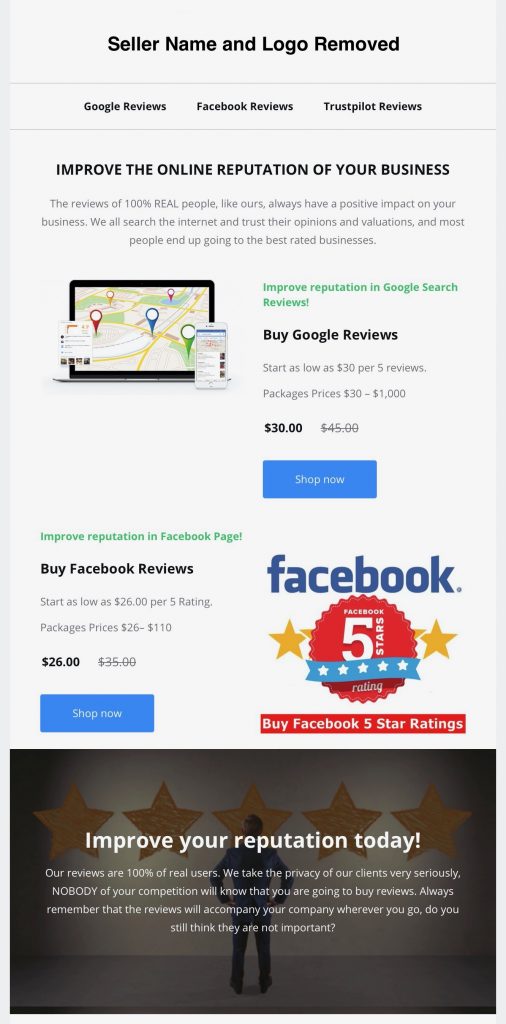We all rely on reviews of products, services, and businesses on Facebook, and with Google search results, or when purchasing products on Amazon. Services like Yelp promise to provide helpful insights from customers. An abundance of positive reviews can almost guarantee trust and help produce new customers.
Unusually High Numbers of 5-Star Ratings
Occasionally while shopping on Amazon you might notice a product with an unusually high number of 5-star reviews. Typically you’ll notice this with off-brand products. An example would be the portable recharging power pack by TOZO. [View] Out of 233 reviews, that battery pack has 98% 5-star reviews and 2% 4-star reviews. There are no 3-star, 2-star, or 1-star reviews. Overall ratings like these could suggest that a vendor or manufacturer has paid for product reviews.
Also, when you look at the written reviews, if they are just a few words like “Works good!” or “Best value!” they could be fake. Amazon has a reviewer verification process to determine if someone is using their real name and also to display if the reviewer is a verified purchaser. If they are using a fake name and there is no record of a purchase of the product (at least from Amazon) such reviews are likely not as trustworthy.
Bad Reviews Explained
Most products on Amazon have 3% to 5% of 1-star reviews. This range of 3% to 5% of dissatisfied product users is a common result of the following factors:
- Bad Vendors. For some products, Amazon rotates through third party vendors to give a variety of vendors an opportunity to sell through the Amazon marketplace. Occasionally a bad vendor will be displayed. A bad vendor would be a company selling defective or used products as new. Bad vendors might also be selling poor quality imitations of brand-name products. Bad vendors sell food, supplements, and medical products that are close to or past their expiration date. This can also happen with printer ink and similar items with a limited shelf-life. All of these factors can result in a bad product review, although those customer reactions have nothing to do with the quality of a properly sold authentic product. They are a reaction to a bad vendor. Even so, they bring down the rating of a product.
- Faulty Products. Sometimes a manufacturing, production, or assembly issue can result in a small failure rate for products such as 1%. Better quality control and testing prior to shipping can fix these issues. So, if a buyer gets one of the 99% of products that aren’t defective from the factory, they may provide a very positive 5-star review while the other 1% of customers will express dissatisfaction. Again, these 1% of reviews reflect a manufacturing issue, not an inherent problem with the majority of products shipped. A variation on this will be products that fail after a short period of time due to poor materials or craftsmanship on some products.
- Used Products. Sometimes poorly managed restocking of returns can result in buyers receiving defective, used, or poorly packaged products. This is not a reflection of the product itself, but dissatisfaction when someone expects to receive a new product and doesn’t. Those processing returns may sometimes put a used product back in the inventory for resale as new.
- Usage or Setup Confusion. Confusion about how to setup or use a product can be a common reason for negative reviews. This is often expressed in poor reviews.
For the above reasons, it’s highly unusual and unlikely for a product to have 0% of reviews that are 3-star, 2-star, or 1-star reviews. A distribution of reviews across the range of stars is what we would expect. In general, we would hope to see a good number of 4 and 5-star reviews, and then smaller numbers of 1 to 3-star reviews. One can read the written comments to learn more about the distribution of buyer satisfaction or dissatisfaction. Sometimes the concerns expressed in poor reviews are not applicable to you. Such as, “This lawnmower is very noisy when in use.” If you plan to wear hearing protection while mowing, you won’t be concerned about the noise.
Paid Reviews
Most consumers aren’t aware of what goes on behind the curtain of product marketing. While some companies are honest and use genuine authentic reviews, others are unscrupulous and pay for fake positive reviews.
Sometimes a company will pay a third party for marketing and that third party will engage in unethical practices without the company being aware this is happening
Perhaps the company knows something unethical is happening, but they can use plausible deniability and claim they had no knowledge of such things going on. The third-party marketing firm is used by them as a firewall to protect the company from the unethical marketing practices. Perhaps the third-party company is setup as a shell company and quickly dismantled to avoid prosecution.
Whatever the circumstances, paid reviews are a big problem and erode public trust.
Example of Paid Reviews Solicitation
Below is an example of a SPAM email from a marketing company that sells positive reviews. The name and logo have been removed. There are many other examples of services like this.
Marketing firms, or perhaps friends or colleagues will tell you, “Everyone is doing it. Buying reviews is the only way a company can have a chance at succeeding in today’s competitive marketplace. Once you seed the reviews with positive ratings, legitimate sales and reviews will come in.” Don’t do it.
It you are someone considering paying for such a service, you should seriously reconsider because you will likely be discovered, and this is considered fraudulent advertising and a deceptive practice which is a criminal activity according to the Federal Trade Commission. You will harm your company and personal reputation, perhaps permanently.
In the real-world example below, the seller name and logo have been removed to avoid unwanted negative attention or attacks.

